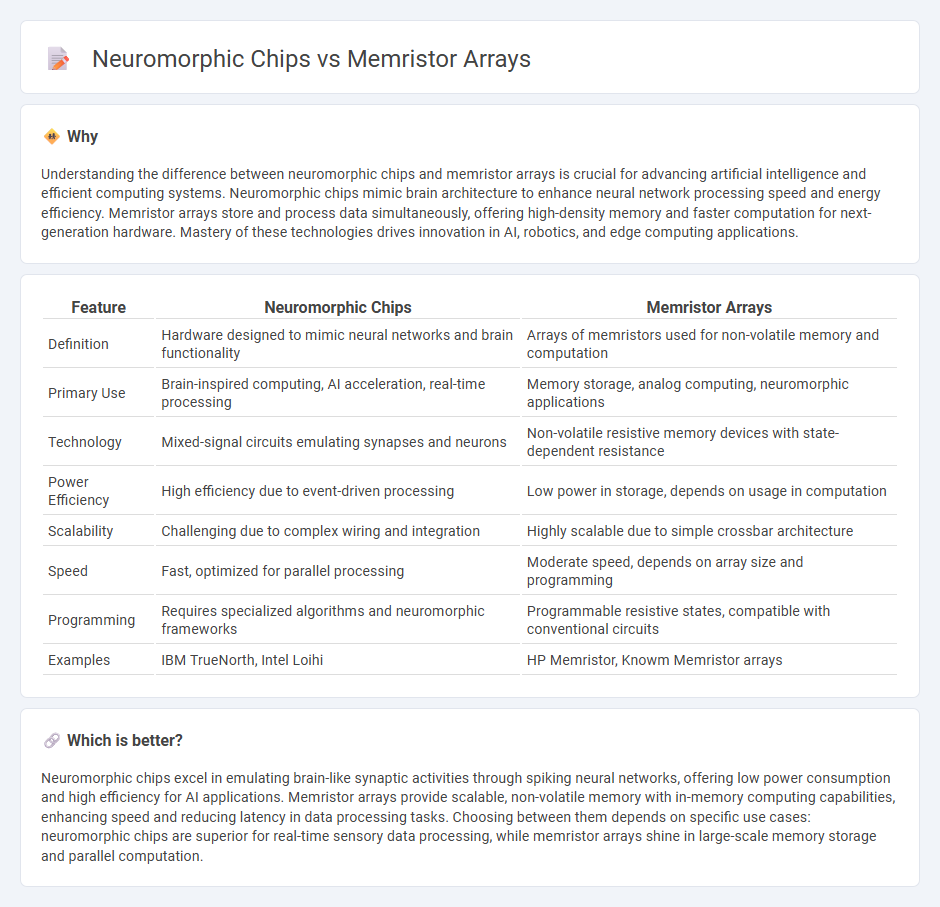
Neuromorphic chips mimic the brain's neural architecture to enable efficient, low-power processing for artificial intelligence applications. Memristor arrays function as non-volatile memory that can also perform computation via resistive switching, offering promising advancement in AI hardware. Explore the latest breakthroughs comparing these technologies to understand their impact on next-generation computing.
Why it is important
Understanding the difference between neuromorphic chips and memristor arrays is crucial for advancing artificial intelligence and efficient computing systems. Neuromorphic chips mimic brain architecture to enhance neural network processing speed and energy efficiency. Memristor arrays store and process data simultaneously, offering high-density memory and faster computation for next-generation hardware. Mastery of these technologies drives innovation in AI, robotics, and edge computing applications.
Comparison Table
| Feature | Neuromorphic Chips | Memristor Arrays |
|---|---|---|
| Definition | Hardware designed to mimic neural networks and brain functionality | Arrays of memristors used for non-volatile memory and computation |
| Primary Use | Brain-inspired computing, AI acceleration, real-time processing | Memory storage, analog computing, neuromorphic applications |
| Technology | Mixed-signal circuits emulating synapses and neurons | Non-volatile resistive memory devices with state-dependent resistance |
| Power Efficiency | High efficiency due to event-driven processing | Low power in storage, depends on usage in computation |
| Scalability | Challenging due to complex wiring and integration | Highly scalable due to simple crossbar architecture |
| Speed | Fast, optimized for parallel processing | Moderate speed, depends on array size and programming |
| Programming | Requires specialized algorithms and neuromorphic frameworks | Programmable resistive states, compatible with conventional circuits |
| Examples | IBM TrueNorth, Intel Loihi | HP Memristor, Knowm Memristor arrays |
Which is better?
Neuromorphic chips excel in emulating brain-like synaptic activities through spiking neural networks, offering low power consumption and high efficiency for AI applications. Memristor arrays provide scalable, non-volatile memory with in-memory computing capabilities, enhancing speed and reducing latency in data processing tasks. Choosing between them depends on specific use cases: neuromorphic chips are superior for real-time sensory data processing, while memristor arrays shine in large-scale memory storage and parallel computation.
Connection
Neuromorphic chips mimic the neural architecture of the human brain, utilizing memristor arrays to emulate synaptic connections for efficient data processing. Memristor technology enables these chips to achieve high-density memory storage and low power consumption by replicating synaptic plasticity. This synergy advances artificial intelligence through enhanced computing speed and reduced energy requirements in neuromorphic systems.
Key Terms
Resistive Switching
Memristor arrays leverage resistive switching properties to store and process information by modulating resistance states, enabling high-density memory and parallel computation. Neuromorphic chips integrate memristive elements with CMOS technology to mimic synaptic functions and achieve energy-efficient neural network processing. Explore further to understand the advancements in resistive switching mechanisms driving next-generation computing architectures.
Spike-based Processing
Memristor arrays offer high-density, energy-efficient storage and computation for spike-based processing by mimicking synaptic weights with analog resistance states, enabling real-time neural signal integration. Neuromorphic chips integrate silicon neurons and synapses to emulate brain-like spiking activity and temporal dynamics, achieving scalable and low-latency spike communication optimized for event-driven tasks. Explore the latest advancements in spike-based neuromorphic hardware to understand their potential in AI and brain-inspired computing.
Synaptic Plasticity
Memristor arrays provide hardware-based synaptic plasticity by modulating resistance states that mimic biological synapses' adaptive strength changes. Neuromorphic chips integrate synaptic plasticity mechanisms through specialized circuits enabling real-time learning and memory functions, closely reflecting neural network dynamics. Explore the latest advancements in synaptic plasticity implementations to understand how these technologies enhance artificial neural processing.
Source and External Links
Multichannel parallel processing of neural signals in memristor arrays - Memristor arrays offer a scalable and power-efficient platform enabling parallel processing of multichannel neural signals, with performance influenced by memristor conductance modulation and signal transformation parameters.
Programming memristor arrays with arbitrarily high precision for analog computing - A novel circuit architecture and programming protocol allow memristor arrays to achieve high-precision analog computing by compensating programming errors using weighted sums of multiple devices.
Memristive Crossbar Arrays for Storage and Computing Applications - Memristors configured in crossbar arrays enable high-density data storage and computing but face challenges such as sneak-path currents, requiring architectural innovations for improved reliability and efficiency.
 dowidth.com
dowidth.com